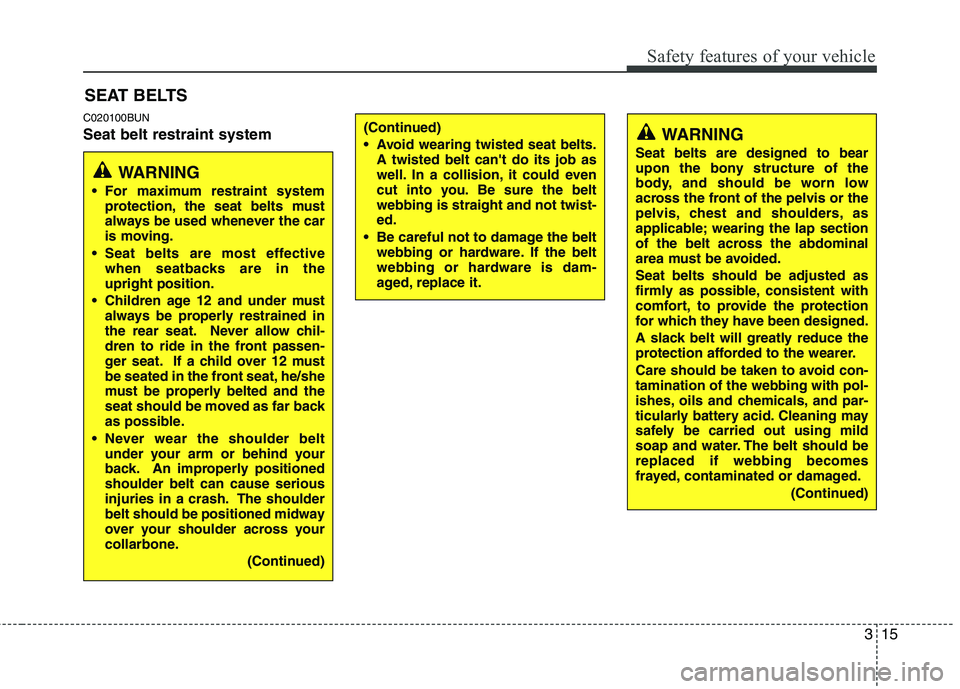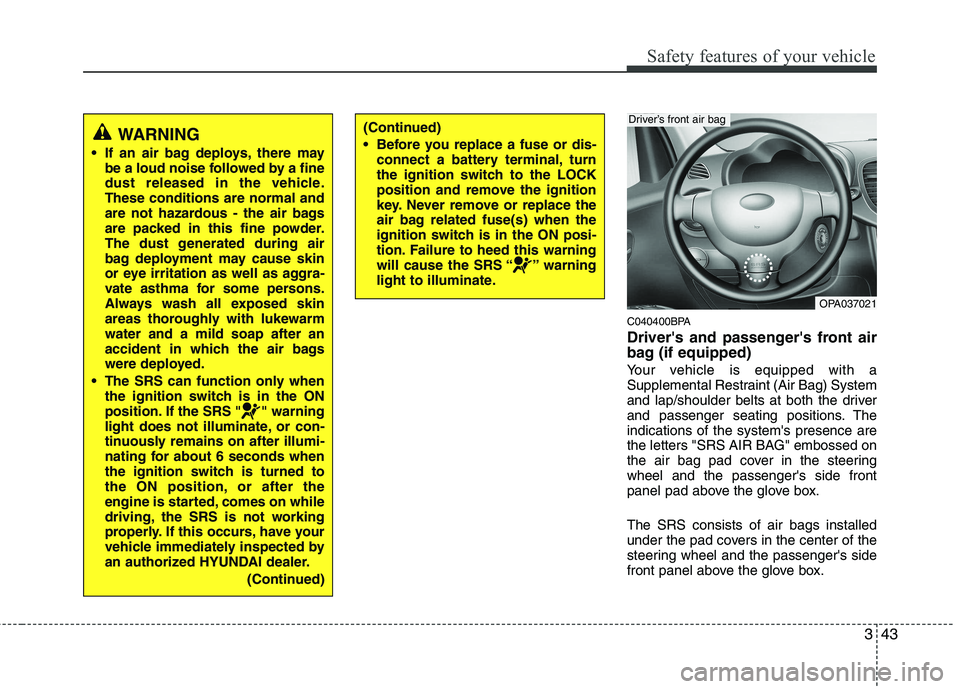Page 17 of 354
Your vehicle at a glance
4
2
ENGINE COMPARTMENT
1. Engine coolant reservoir ...................7-27
2. Engine oil filler cap ...........................7-26
3. Brake/clutch fluid reservoir ...............7-29
4. Air cleaner.........................................7-33
5. Fuse box ...........................................7-51
6. Positive battery terminal ...................7-39
7. Negative battery terminal..................7-39
8. Automatic transaxle fluid dipstick* ....7-30
9. Radiator cap .....................................7-28
10. Engine oil dipstick ...........................7-25
11. Windshield washer fluid reservoir ...7-32
* : if equipped
OPA017004
B030000APA■
■
Gasoline Engine (1.1L)
Page 18 of 354
25
Your vehicle at a glance
1. Engine coolant reservoir ...................7-27
2. Engine oil filler cap ...........................7-26
3. Brake/clutch fluid reservoir ...............7-29
4. Air cleaner.........................................7-33
5. Fuse box ...........................................7-51
6. Positive battery terminal ...................7-39
7. Negative battery terminal..................7-39
8. Automatic transaxle fluid dipstick* ....7-30
9. Radiator cap .....................................7-28
10. Engine oil dipstick ...........................7-25
11. Windshield washer fluid reservoir ...7-32
* : if equipped
■
■
Gasoline Engine (1.2L)
OPA079102
Page 19 of 354
Your vehicle at a glance
6
2
1. Engine coolant reservoir ...................7-27
2. Engine oil filler cap ...........................7-26
3. Brake/clutch fluid reservoir ...............7-29
4. Air cleaner.........................................7-33
5. Fuse box ...........................................7-51
6. Positive battery terminal ...................7-39
7. Negative battery terminal..................7-39
8. Radiator cap .....................................7-28
9. Engine oil dipstick .............................7-25
10. Windshield washer fluid reservoir ...7-32
* : if equipped
■
■
Gasoline Engine (1.0L)
OPA071100N
Page 34 of 354

315
Safety features of your vehicle
C020100BUN Seat belt restraint systemSEAT BELTS
WARNING
For maximum restraint system protection, the seat belts must
always be used whenever the car
is moving.
Seat belts are most effective when seatbacks are in theupright position.
Children age 12 and under must always be properly restrained in
the rear seat. Never allow chil-
dren to ride in the front passen-
ger seat. If a child over 12 must
be seated in the front seat, he/she
must be properly belted and the
seat should be moved as far back
as possible.
Never wear the shoulder belt under your arm or behind your
back. An improperly positionedshoulder belt can cause serious
injuries in a crash. The shoulder
belt should be positioned midway
over your shoulder across your
collarbone.
(Continued)
WARNING
Seat belts are designed to bear
upon the bony structure of the
body, and should be worn low
across the front of the pelvis or the
pelvis, chest and shoulders, as
applicable; wearing the lap section
of the belt across the abdominal
area must be avoided. Seat belts should be adjusted as
firmly as possible, consistent with
comfort, to provide the protection
for which they have been designed.
A slack belt will greatly reduce the
protection afforded to the wearer.
Care should be taken to avoid con- tamination of the webbing with pol-
ishes, oils and chemicals, and par-
ticularly battery acid. Cleaning may
safely be carried out using mild
soap and water. The belt should bereplaced if webbing becomes
frayed, contaminated or damaged.
(Continued)(Continued)
Avoid wearing twisted seat belts.A twisted belt can't do its job as
well. In a collision, it could even
cut into you. Be sure the beltwebbing is straight and not twist-ed.
Be careful not to damage the belt webbing or hardware. If the belt
webbing or hardware is dam-
aged, replace it.
Page 62 of 354

343
Safety features of your vehicle
C040400BPA
Driver's and passenger's front air
bag (if equipped)
Your vehicle is equipped with a
Supplemental Restraint (Air Bag) System
and lap/shoulder belts at both the driver
and passenger seating positions. Theindications of the system's presence are
the letters "SRS AIR BAG" embossed on
the air bag pad cover in the steeringwheel and the passenger's side front
panel pad above the glove box. The SRS consists of air bags installed
under the pad covers in the center of the
steering wheel and the passenger's side
front panel above the glove box.
WARNING
If an air bag deploys, there may be a loud noise followed by a fine
dust released in the vehicle.These conditions are normal and
are not hazardous - the air bags
are packed in this fine powder.
The dust generated during air
bag deployment may cause skin
or eye irritation as well as aggra-
vate asthma for some persons.
Always wash all exposed skin
areas thoroughly with lukewarmwater and a mild soap after an
accident in which the air bags
were deployed.
The SRS can function only when the ignition switch is in the ON
position. If the SRS " " warning
light does not illuminate, or con-
tinuously remains on after illumi-
nating for about 6 seconds when
the ignition switch is turned to
the ON position, or after the
engine is started, comes on while
driving, the SRS is not working
properly. If this occurs, have your
vehicle immediately inspected by
an authorized HYUNDAI dealer.
(Continued)(Continued)
Before you replace a fuse or dis-connect a battery terminal, turn
the ignition switch to the LOCK
position and remove the ignition
key. Never remove or replace the
air bag related fuse(s) when the
ignition switch is in the ON posi-
tion. Failure to heed this warning
will cause the SRS “ ” warning
light to illuminate.
OPA037021
Driver’s front air bag
Page 84 of 354

45
Features of your vehicle
Type B
Lock
All doors (and tailgate) are locked if the
lock/unlock button (1) is pressed when a
front door is unlocked. If all doors (and tailgate) are closed, the
hazard warning lights blink once to indi-cate that all doors (and tailgate) are
locked.
However, if any door (or tailgate) remains
open, the hazard warning lights will not
operate. If all doors (and tailgate) are
closed after the lock button is pressed,
the hazard warning lights blink.D020102APA
Unlock
All doors (and tailgate) are unlocked if
the lock/unlock button (1) is pressed
when both front doors are locked.
The hazard warning lights will blink twice again to indicate that all doors (and tail-
gate) are unlocked.
After depressing this button, the doors
(and tailgate) will be locked automatical-
ly unless you open any door within 30
seconds.
D020200AFD
Transmitter precautions
✽✽
NOTICE
The transmitter will not work if any of
following occur:
The ignition key is in ignition switch.
You exceed the operating distance limit (about 10 m [30 feet]).
The battery in the transmitter is weak.
Other vehicles or objects may be blocking the signal.
The weather is extremely cold.
The transmitter is close to a radio transmitter such as a radio station or
an airport which can interfere with
normal operation of the transmitter.
When the transmitter does not work
correctly, open and close the door with
the ignition key. If you have a problem
with the transmitter, contact an author-
ized HYUNDAI dealer.
OTQ047002
CAUTION
Keep the transmitter away from water or any liquid. If the keyless entry system is inoperative due toexposure to water or liquids, it will
not be covered by your manufactur-er vehicle warranty.
Page 85 of 354
Features of your vehicle
6
4
D020300AFD
Battery replacement
Type A
Transmitter uses a 3 volt lithium battery
which will normally last for several years.
When replacement is necessary, use the
following procedure.
1. Insert a slim tool into the slot and gen-
tly pry open the transmitter center
cover (1).
2. Replace the battery with new one. When replacing the battery, make sure
the battery positive “+” symbol faces
up as indicated in the illustration.
3. Install the battery in the reverse order of removal. For replacement transmitters, see an
authorized HYUNDAI dealer for repro-
gramming.
Type B
Transmitter uses a 3 volt lithium battery
which will normally last for several years.
When replacement is necessary, use the
following procedure.
1. Remove the screw (1) using a philips
head screwdriver.
2. Insert a slim tool into the slot and gen- tly pry open the transmitter center
cover.
3. Remove the battery cover (2).
OFD047003OPA047003
Page 86 of 354

47
Features of your vehicle
4. Replace the battery with a new battery(CR1220). When replacing the battery,
make sure the battery positive “+” sym-
bol faces up as indicated in the illus-
tration.
5. Install the battery in the reverse order of removal.
For replacement transmitters, see an
authorized HYUNDAI dealer for transmit-
ter reprogramming.CAUTION
• The keyless entry system trans- mitter is designed to give you
years of trouble-free use, howev-er it can malfunction if exposed tomoisture or static electricity. If you are unsure how to use your
transmitter or replace the battery,contact an authorized HYUNDAIdealer.
Using the wrong battery can cause the transmitter to malfunc-tion. Be sure to use the correct battery.
To avoid damaging the transmit- ter, don't drop it, get it wet, or
expose it to heat or sunlight.
CAUTION
An inappropriately disposed bat-tery can be harmful to the environ- ment and human health.
Dispose the battery according toyour local law(s) or regulation.